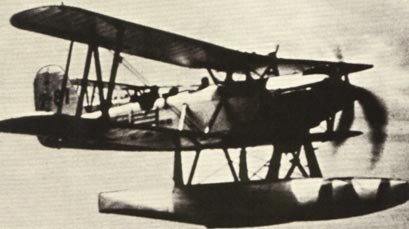The Kawanishi E7E, codenamed “Alf” by the Allies, was a three seat reconnaissance floatplane. In the spring of 1932, the Japanese Imperial Navy asked the Kawanishi Aircraft Corporation to develop a replacement for the company’s vaunted E5K reconnaissance platform. The proposed replacement, the E7K-1was conceived as an equal span, biplane configuration which would be powered by the Hiro 91, 620hp engine.
After less than a year of research and development, the first E7K took to the air for its maiden flight on the morning of February 6th, 1933. After a series of tests flights which pitted the new model against an Aichi platform, the Navy gave the company the “go ahead” to begin full production of the new biplane. Designed to operate from ships or land bases, the E7K’s profile called for, beside recon sorties, anti-ship and submarine patrols in the vast Pacific Ocean.
In the early months of 1935, the Japanese Navy accepted the new aircraft into its operational inventory, only three years since their original request order. The aircraft performed well enough to began deployment operations soon after. Nevertheless, the top brass of the Navy wanted a new aircraft, one that would achieve a greater aloft time (the E7K could stay in the air for almost 12 hours), and range than the “Alf” was capable.
The company’s effort to fulfill that new requirement came in the form of the E7K-2 version, with the same fuselage as the 1 model, designed around the new and improve Hiro 91a power plant. But the aircraft proved to be grossly under power. Another attempt was made with the same base frame of the E7K-2, but this time the engine was different. The Mitsubishi Zuisei 11 radial engine was chosen as the new plane’s power plant. A decision that resulted in the extension of based aircraft’s operational life.
The new platform made its first flight in August 1938. The Japanese Navy was highly impressed by the 2’s handling characteristics and all around performance that it immediately placed the program into full production status. Officially, the E7K-2 or Type 94 became the main stay of the force recon arm during the early years of the war. With the arrival of the version 2, most E7K-1 units removed from front line service and assigned training duties. The E7K-2 remained in operational service until the fall of 1943, when they were officially decommissioned from the Navy’s sea recon structure.
But the removal from active service did not meant the end of the aircraft as a functional tool of war. As with much of Japan’s ever shrinking aircraft inventory, the E7K 1 and 2 versions were employed as kamikaze attack platforms toward the end of the war. In the end, 183 E7K-1s units were produced. A total of 350 of the 2 version were also developed.
| Power Plant | One Mitsubishi 870hp Zuisei 11 radial engine |
| Wingspan | 14m |
| Length | 10.5m |
| Height | 4.85m |
| Total Wing Area | 43.6m sq. |
| Maximum Takeoff Weight | 3,300kg |
| Top Operational Speed | 275kph |
| Service Ceiling | 7,060m |
| Climb Rate | 3,00m per minute |
| Range | 1,845km |
